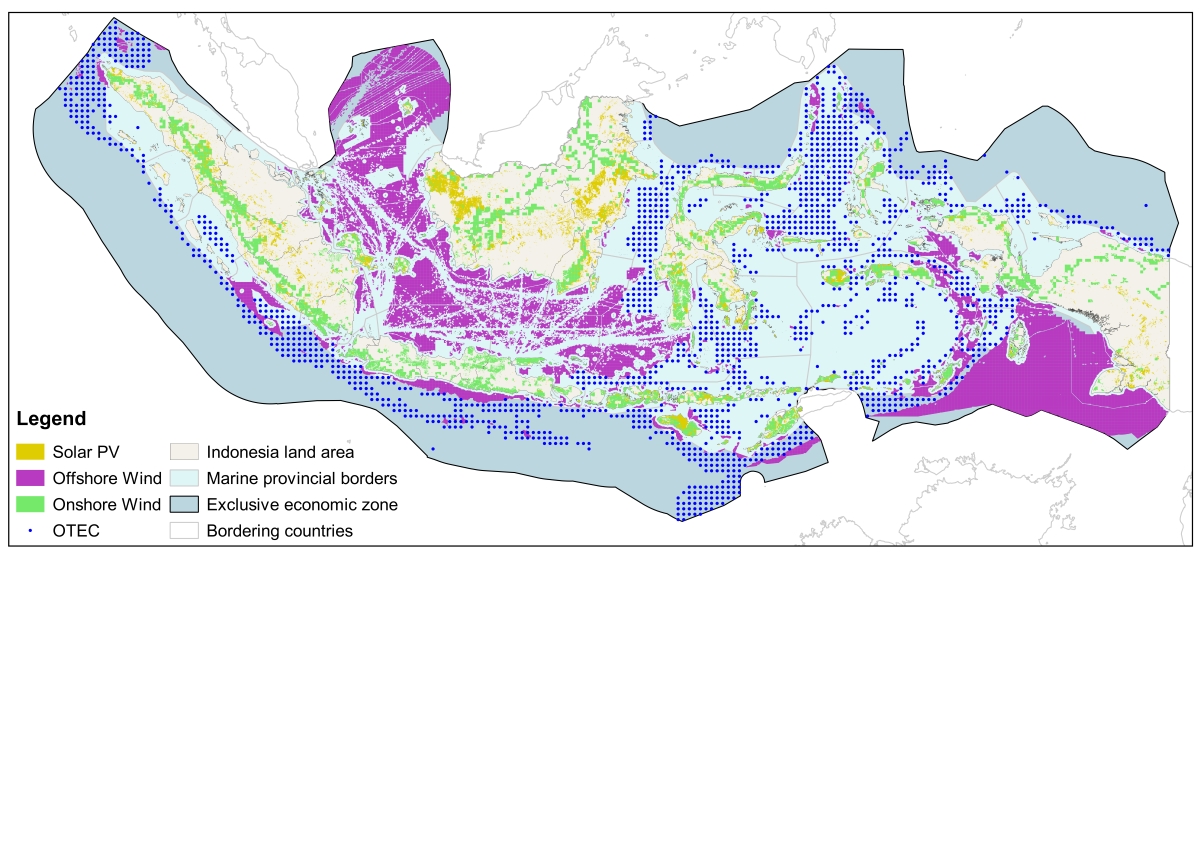Technical potential of renewables in Indonesia

Indonesia is a country with huge renewable energy potential, essentially to enable the Net Zero 2060 ambition. The figure summarises 3 years of research by PhD candidate Jannis Langer on renewable resource mapping in Indonesia. The map shows the technical potential in Indonesia for four renewable energy technologies, namely solar photovoltaics, onshore and offshore wind, as well as Ocean Thermal Energy Conversion (OTEC), a promising early-stage technology that uses the heat of ocean water to produce electricity. The resources are mapped considering constraints from nature conservation zones, areas prone to natural catastrophes (e.g. earthquakes), urban environment, and many others. Despite these constraints, Indonesia’s renewable energy resources are still massive and amount to roughly 20,000 TWh per year. This is roughly 75% of the electricity consumed by the entire world in 2019, and can meet Indonesia’s projected electricity demand in 2050 5–21 times. However, most of these resources are not located at places where electricity demand is high. One way to address this could be to connect Indonesia’s islands via sub-sea power transmission cables. With these cables, the renewable electricity can be transported to the locations where it is needed.
For further details, we refer to the papers listed below, or contact Jannis Langer directly via j.k.a.langer@tudelft.nl
- Langer J, Kwee Z, Zhou Y, Isabella O, Ashqar Z, Quist J, et al. Geospatial analysis of Indonesia ’ s bankable utility-scale solar PV potential using elements of project finance. Energy 2023;283:128555. doi.org/10.1016/j.energy.2023.128555.
- Langer J, Zaaijer M, Quist J, Blok K. Introducing site selection flexibility to technical and economic onshore wind potential assessments: New method with application to Indonesia. Renew Energy 2023;202:320–35. doi.org/10.1016/j.renene.2022.11.084.
- Langer J, Simanjuntak S, Pfenninger S, Laguna AJ, Lavidas G, Polinder H, et al. How offshore wind could become economically attractive in low-resource regions like Indonesia. IScience 2022;25:104945. https://doi.org/10.1016/j.isci.2022.104945.
- Langer J, Cahyaningwidi AA, Chalkiadakis C, Quist J, Hoes O, Blok K. Plant siting and economic potential of ocean thermal energy conversion in Indonesia a novel GIS-based methodology. Energy 2021;224:120121. doi.org/10.1016/j.energy.2021.120121.
Context: Indonesia is a country with a strongly growing economy. Its rising electricity demand is currently mostly satisfied with power plants that use fossil fuels, like coal and natural gas. These plants emit large amounts of greenhouse gases, like CO2, and thus contribute to climate change via global warming. Replacing fossil-fuel-based power plants with renewables, like solar and wind energy, is one of the most important ways of reducing greenhouse emissions and thus mitigating the impacts of climate change. However, renewables cannot be placed anywhere and must be placed carefully with technical, economic, environmental, and social constraints in mind.